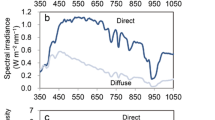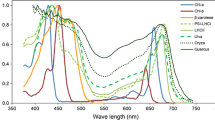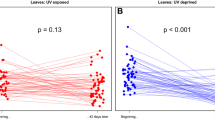Abstract
Spectral reflectance and transmittance of leaves to ultraviolet irradiation were determined under laboratory conditions for seven species of hardwood trees, namely red oak (Quercus rubra, L), black oak (Q. velutina, Lamarch), white oak (Q. alba, L.), sugar maple (Acer saccharum), Norway maple (A. plantanoides), hickory (Carya tomemtosa), sweetgum (Liquidambar styraciflua), and black oak litter. The experimental system consisted of a solar simulator, an integrating sphere, and a spectroradiometer. Experiments were repeated three to five times for both adaxial and abaxial surfaces of fresh leaves chosen at randomly. The spectral distributions and simple averages of the radiative properties in the wavelength ranges of ultraviolet-B (UV-B, 280–320 nm) and ultraviolet-A (UV-A, 320–400 nm) were determined. The spectral distributions of reflectance were similar between adaxial and abaxial surfaces, although the magnitude varied among tree species. Leaf reflectance was very low for the ultraviolet spectrum in general and varied among species and between adaxial and abaxial surfaces. It was generally higher over the UV-A waveband compared to UV-B, and higher on the abaxial than adaxial surface. The broadband reflectance in the UV-A range (over all species) was 5.0 and 3.9% for abaxial and adaxial surface, respectively, compared to 3.5 and 2.8% in UV-B. The transmittance through leaves was extremely small in the UV-B (<0.1%) and nearly zero in the UV-A spectral range. Consequently, the absorptance of ultraviolet radiation by leaves, as determined from the measured reflectance and transmittance, was quite high, being more than 90% for all the combinations of species and wavebands examined. The reported results are useful for studies requiring spectral radiative properties of the examined leaves with respect to ultraviolet irradiation.
Similar content being viewed by others
References
Blumthaler M, Ambach W (1990) Indication of increasing solar ultraviolet-B radiation flux in Alpine regions. Science 248:206–208
Caldwell MM, Teramura AH, Tevini M (1989) The changing solar ultraviolet climate and the ecological consequences for higher plants. Trends Ecol Evol 4:363–367
Correll DL, Clark CO, Goldberg B, Goodrich VR, Hayes DRJr, Klein WH, Schecher WD (1992) Spectral ultraviolet-B radiation fluxes at the earth's surface: long-term variations at 39°N, 77°W. J Geophys Res Atmos 97:7579–7591
Gausman HW, Rodriguez RR, Escobar, DE (1975) Ultraviolet radiation reflectance, transmittance, and absorptance by plant leaf epidermises. Agron J 67:720–724
Gibson JH (1992). Criteria for status-and-trends monitoring of ultraviolet (UV) radiation. Report of UV-B measurements, Workshop II, Washington, DC. Natural Resources Ecology Laboratory, Colorado State University, Fort Collins, Colorado
Green AES, Sawada T, Shettle EP (1974) The middle ultraviolet reaching the ground. Photochem Photobiol 19:251–259
Kerr BJ, McElroy CT (1993) Evidence for large upward trends of ultraviolet-B radiation linked to ozone depletion. Science 262:1032–1034
Krupa SV, Kickert RN (1989) The greenhouse effect: impacts of ultraviolet-B (UV-B) radiation, carbon dioxide (CO2), and ozone (O3) on vegetation. Envir Pollut 61:263–393
LI-COR (1982) LI-1800 portable spectroradiometer instruction manual. LI-COR, Lincoln, Nebraska
Robberecht R, Caldwell MM (1986) Leaf UV optical properties ofRumex patientia L. andRumex obtusifolius L. in regard to a protective mechanism against solar UV-B radiation injury. In: Worrest RC, Caldwell MM (eds) Stratospheric ozone reduction, solar ultraviolet radiation and plant life. Springer, New York, pp 251–259
StatSoft (1991) Reference for statistical procedures (DOS and Windows Versions) STATISTICA. StatSoft, Tulsa, Oklahoma
Urbach F (1989) Potential effects of altered solar ultraviolet radiation on human skin cancer. Photochem Photobiol 50:507–514
USEPA (1989) Workshop on monitoring the effects of UV-B radiation. Atmospheric Research and Experimental Assessment Laboratory, Research Triangle Park, North Carolina
Velleman PF, Hoaglin DC (1981) Applications, basics, and computing of exploratory data analysis. Duxbury Press, Belmont, California
Waller RA, Duncan DB (1969) A bayes rule for the symmetric multiple comparisons problem. J Am Stat Assoc 64:1484–1503
Yang X (1993) Potential irradiance of biologically active radiation on ground. (ASAE paper no. 934543) ASAE, St. Joseph, Michigan
Yang X, Short TH, Fox RD, Bauerle WL (1991) A theoretical model of solar radiation transfer in a row-crop canopy. Trans ASAE 33:917–924
Yang X, Miller DR, Montgomery ME (1993) Vertical distributions of canopy foliage and biologically active radiation in a defoliated/refoliated hardwood forest. Agric For Meteorol 67:129–146
Author information
Authors and Affiliations
Rights and permissions
About this article
Cite this article
Yang, X., Heisler, G.M., Montgomery, M.E. et al. Radiative properties of hardwood leaves to ultraviolet irradiation. Int J Biometeorol 38, 60–66 (1995). https://doi.org/10.1007/BF01270660
Received:
Revised:
Accepted:
Issue Date:
DOI: https://doi.org/10.1007/BF01270660




